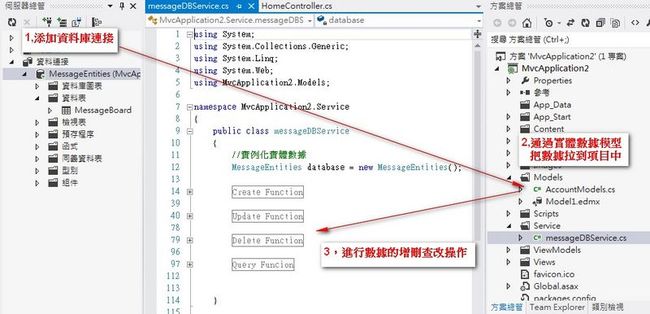ASP.NET MVC 4.0 学习4-Code First
之前我們需要用到的數據,通過添加Entity實體數據模型把數據庫中需要的Database拉到項目中如下圖,
而就是Code First就是相對於這種處理數據的方法而言的
Code First更加準確的解讀是開發人員只需要編寫程式(Code Only),系統會自動建立模型和數據庫
我們來新建一個專案看一下Code First的具體實現
1,新專案的Model中加入類別MessageBoard存儲留言信息
MessageBoard.cs中添加字段屬性:
using System; using System.Collections.Generic; using System.Linq; using System.Web; using System.ComponentModel.DataAnnotations; using System.ComponentModel; namespace MvcApplication3.Models { public class MessageBoard { [Key] public int MsgID { get; set; } [Required] [DisplayName("姓名:")] public string Title { get; set; } [Required] [DisplayName("內容")] public string Content { get; set; } } }
2,Ctrl+Shift+B重建方案後,添加MessageController
範本選擇讀寫功能,模型類別選擇剛建立的Model中的MessageBoard
確認以後,我們看到Models和Views中自動生成了對應的文件,MessageController.cs和View中自動添加了相應增刪改:
Ctrl+F5運行程式,輸入Message如:http://localhost:64570/Message 我們看到了Message的首頁,並且可以添加留言
增刪查改的功能是我們剛才在添加控制器的時候選擇了“具有讀取/寫入...”功能系統自動實現的:
我們剛才並沒有建立數據庫,新增的留言存放在哪裡了?
項目中點擊查看所有文件,我們發現App_Data下面產生了.mdf文件,.mdf文件以及Models下的MvcApplication3Context.cs也是在我們添加MessageController這一步選擇“資料內容類別”的時候產生的:
雙擊.mdf我們看到了生成的Table和Models下MessageBoard.cs中的屬性是一致的:
這就是Code First ,我們只需要去編寫Models中的模型,添加Controller時候系統自動幫我們生成了和模型一致的數據庫文件
接下來我們再看一下Models中的模型:
Code First,Model資料模型中的class對應生成了數據庫中的Table: MessageBoard.cs 對應 MessageBoards表
Model中的Class除了對屬性進行定義外,還能定義Table的名稱,Table中的主鍵以及Table間的一對多 多對多關係:
Model中添加兩個模型類,BookModel.cs和AuthorModel.cs,類中借住System.Collenctons命名空間下的Icollection實現了表與表之
間的對應關係:
1,更新MessageBoard.cs類,添加Book和Author的模型定義:
using System; using System.Collections.Generic; using System.Linq; using System.Web; using System.ComponentModel.DataAnnotations; using System.ComponentModel; using System.ComponentModel.DataAnnotations.Schema; namespace MvcApplication3.Models { public class MessageBoard { [Key] public int MsgID { get; set; } [Required] [DisplayName("姓名:")] public string Title { get; set; } [Required] [DisplayName("內容")] public string Content { get; set; } } //定義表名稱 [Table("MyTable")] public class BookModels { //定義主鍵Key [Key] [DatabaseGeneratedAttribute(DatabaseGeneratedOption.Identity)] public int BookID { get; set; } [Required] public string BookName { get; set; } [Required] public DateTime PublishTime { get; set; } //Book和作者的對應關係: N*1 public AuthorModels AuthorModels { get; set; } } //定義表名稱 [Table("Author")] public class AuthorModels { [Key] [DatabaseGeneratedAttribute(DatabaseGeneratedOption.Identity)] public int AuthorID { get; set; } [Required] public string Name { get; set; } //作者和數的對應關係:一個作者對應多本數 1*多 [Required] public ICollection<BookModels> BookModels { get; set; } } }
2,更新MvcApplication3Context.cs文件:
using System.Data.Entity; namespace MvcApplication3.Models { public class MvcApplication3Context : DbContext { // 您可以將自訂程式碼新增到這個檔案。變更不會遭到覆寫。 // // 如果您要 Entity Framework 每次在您變更模型結構描述時 // 自動卸除再重新產生資料庫,請將下列 // 程式碼新增到 Global.asax 檔案的 Application_Start 方法中。 // 注意: 這將隨著每次模型變更而損毀並重新建立您的資料庫。 // // System.Data.Entity.Database.SetInitializer(new System.Data.Entity.DropCreateDatabaseIfModelChanges<MvcApplication3.Models.MvcApplication3Context>()); public MvcApplication3Context() : base("name=MvcApplication3Context") { } public DbSet<MessageBoard> MessageBoards { get; set; } public DbSet<BookModels> BookModels { get; set; } public DbSet<AuthorModels> AuthorModels { get; set; } } }
3,打開套件管理器控制臺,逐步執行以下命令:
以下是Code First Migration功能可以參考:http://msdn.microsoft.com/en-us/data/jj193542
- PM> Enable-Migrations -Force -ContextTypeName MvcApplication3.Models.MvcApplication3Context
- PM> Add-Migration AddNewMessageBoard
- PM> Update-Database
執行成功:
數據庫中我們看到新增加的Table:














